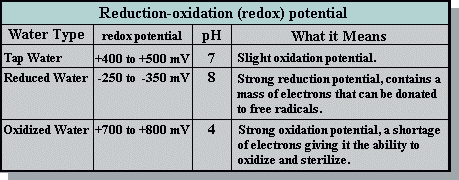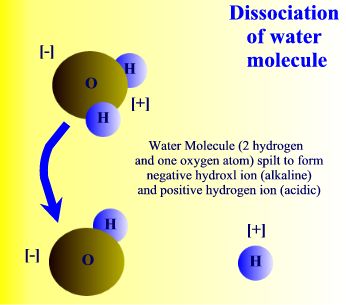pH Pocket Chart?
Alkalize, energize, detoxify,
FEEL BETTER- drink
high pH alkaline water
and use frequency healing
from the
for optimal wellness
and anti-aging!
What is ORP?
ORP stands for Oxidation Reduction Potential. Water either has a "positive" or "negative" ORP, measured in millivolts mV. It is the negative ORP that is beneficial to our body in that it reduces oxidation (anti-oxidant). Negative ORP is in ionized water and fresh, uncooked foods. Positive ORP increases oxidation (aging) and is found in tap water, bottled waters, distilled and reverse osmosis waters as well as cooked and processed foods.
Redox Potential Comparison
After electrolysis of the water inside the Ionized Water unit, reduced water comes out of the cathodic side (alkaline drinking side) and oxidized water comes out of the anodic side (acidic waste side). Compare these measurements of these three types of water: tap water before electrolysis, the reduced water, and the oxidized water.

Other forms of filtration remove various chemicals and/or minerals from the water, but it is still acidic oxidized water with a positive ORP that increases oxidation (aging).
Redox Potential, Not pH, is the Crucial Factor
Traditionally we have judged the properties of water from the standpoint of pH, in other words whether water is acidic or alkaline. According to Dr. Yoshiaki Matsuo PhD., the inventor of the ionized water unit, "In my opinion, redox potential is more important than pH. The importance of pH is over emphasized. For example, the average pH of blood is 7.4 and acidosis or alkalosis are defined according to deviation within the range of 7.4 +- 0.005. But nothing has been discussed about ORP, or oxidation reduction potential."
The pH of tap water is about pH 7, or neutral. When tap water is electrolyzed into ionized Water, its reduced water has a pH of about 9-10 and the oxidized water a pH of about 4-5. Even if you make alkaline water of pH 9 by adding sodium hydroxide or make acidic water of pH 3 by adding hydrogen chloride, you will find very little change in the ORP values of the two waters. On the other hand, when you divide tap water with electrolysis you can see the ORP fluctuate by as much as 1,000 mV. By electrolysis we can obtain reduced water with negative potential that is beneficial for the body.
In the "Benefits of Alkaline, Ionized Water," By Dr. Hidemitsu Hayashi, M.D., Director of the Water Institute of Japan he tells us that antioxidants block dangerous oxidation caused by over acidity. One way to protect healthy tissue from the ravages of oxidation is to provide free electrons to active oxygen radicals, thus neutralizing their high oxidation potential and preventing them from reacting with healthy tissue.

Water treated by electrolysis to increase its reduction potential is the best solution to the problem of providing a safe source of free electrons to block the oxidation of normal tissue by free oxygen radicals. We believe that reduced alkaline water, water with an excess of free electrons to donate to active oxygen, is the best solution because:
1. The reduction potential of water can be dramatically increased over other antioxidants in food or vitamin supplements.
2. The molecular weight of reduced water is low, making it fast acting and able to reach all tissues of the body in a very short time.
What Ionized Water Does...
The water ionizer produces two kinds of water with different redox potentials, one with a high reduction potential and the other with a high oxidation potential.
When taken internally, the reduced alkaline ionized water, with its redox potential of -250 to -400mV, readily donates its electrons to oddball oxygen free radicals and blocks the interaction of the active oxygen with normal molecules.
Undamaged biological molecules are less susceptible to infection and disease. Ionized water gives up an extra electron and reduces the active oxygen (AO), thus rendering it harmless. The AO is reduced without damaging surrounding biological molecules. Substances which have the ability to counteract active oxygen by supplying electrons are called scavengers. Reduced water, therefore, can be called scavenging water.
When taken internally, the effects of reduced water are immediate. Ionized water inhibits excessive fermentation in the digestive tract by reducing indirectly metabolites such as hydrogen sulfide, ammonia, histamines, indoles, phenols and scatoles, resulting in a cleaner stool within days after reduced water is taken on a regular basis. In 1965, the Ministry of Welfare of Japan announced that reduced water obtained from electrolysis can prevent abnormal fermentation of intestinal microbes.
The Chinese adepts well knew the power of this ionization process. They call the energy in the body chi, and they say it comes from the air, from water and from food. In his book The Tao of Health, Sex and Longevity, author and longevity expert Daniel Reid says, "Since there exists no equivalent term in English for 'Chi' or Prana, we shall refer to it as 'bionic' or 'bioelectric' energy. This combines the idea of living energy uniquely associated with living organisms (bio-) with that of electricity (-electric) and negatively charged ions (-ionic).."
More recently, French Scientist Dr J. Belot said,
"When we consider organic life in the light of biophysics, we find that electrical phenomena are at the root of all cellular life and we conclude that the end of everything is an electrical charge."
In March 1968, 36 years ago, Le Monde reported that the presence of negative ions or ionization facilitates oxygen absorption, aids elimination of CO2 in the alveoli of the lungs, yet positive ions have precisely the opposite effect. Gases, dust, chemical fumes, all enter the body as positive ions, trapping the tiny negative ions in their large absorbent form, rendering your air technically 'dead'.


 Affiliate Login
Affiliate Login View Cart
View Cart Home
Home